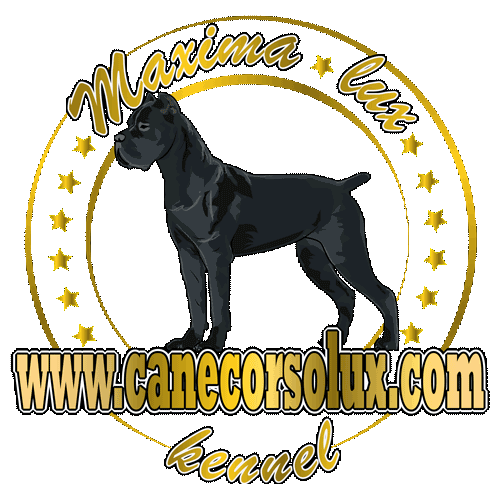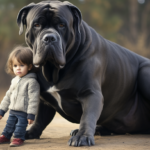Cane Corso is a vast and muscular Italian breed recognized for its loyalty and protective temperament. They are different from other breeds in size, temperament, and unique heritage as working dogs for hunting and guarding livestock.
Dogs are among the most well-liked and well-known creatures on the planet. However, hundreds of breeds exist, each with a unique background and personality. This essay will examine the Cane Corso breed and discuss what makes it unique.
The Cane Corso is a big, strong, muscular Italian dog breed. The original purpose of this dog breed, also known as the Italian Mastiff, was to hunt, guard, and herd animals. However, the Cane Corso has evolved into a popular dog breed for modern households, praised for its devotion, intelligence, and protective demeanor.
In the following article, we will closely examine the Cane Corso breed, discussing its origins, appearance, personality, health, activity requirements, socialization, and overall appeal. We’ll examine how this breed stacks up against others and emphasize its distinguishing features.
If you love dogs, breed them, or are just thinking about getting one, this essay will provide you all the information you need to make an informed decision about the Cane Corso. So, let’s dive into the world of the Cane Corso and find out what makes it stand out from other dog breeds.
Roman Molossus to Modern Protector: The Cane Corso’s Evolution
A long and fascinating history that goes back to ancient times can be found for the Cane Corso breed. The breed is thought to have originated in Apulia in southern Italy and was developed mainly for hunting, guarding, and herding animals.
Roman troops probably domesticated the breed’s forebears, giant, powerful dogs employed for defending property and fighting in battles. The ancient Molossus breed was revered for its steadfastness and bravery. The Cane Corso evolved from the Molossus through decades of careful crossbreeding with native Italian dog breeds.
The Cane Corso was a popular breed of dog in Italy during the Middle Ages, serving various purposes, including defending land and hunting wild boar. However, the Cane Corso’s popularity dropped as demand for working dogs decreased, and the breed nearly went extinct in the twentieth century.
A group of dog lovers in Italy started a breeding program in the 1970s to bring the Cane Corso back from extinction. The survivors, who mainly served as hunting and guard dogs, were utilized to rebuild the breed. As a result, the breed’s traditional characteristics, such as its robust build, powerful jaws, and loving nature, have been brought back through selective breeding.
Major canine organizations like the American Kennel Club (AKC), the United Kennel Club (UKC), and the Fédération Cynologique Internationale (FCI) now recognize the Cane Corso as a separate breed. It’s also famous for service roles, including police work, Search and Rescue (SAR), and therapy.
To sum up, the Cane Corso has advanced considerably from its Molossus ancestry. The breed’s development shows how crucial it is to safeguard the canine past. The Cane Corso is a popular family pet and fearless protector thanks to its sturdy build, strong jaws, and loving nature.
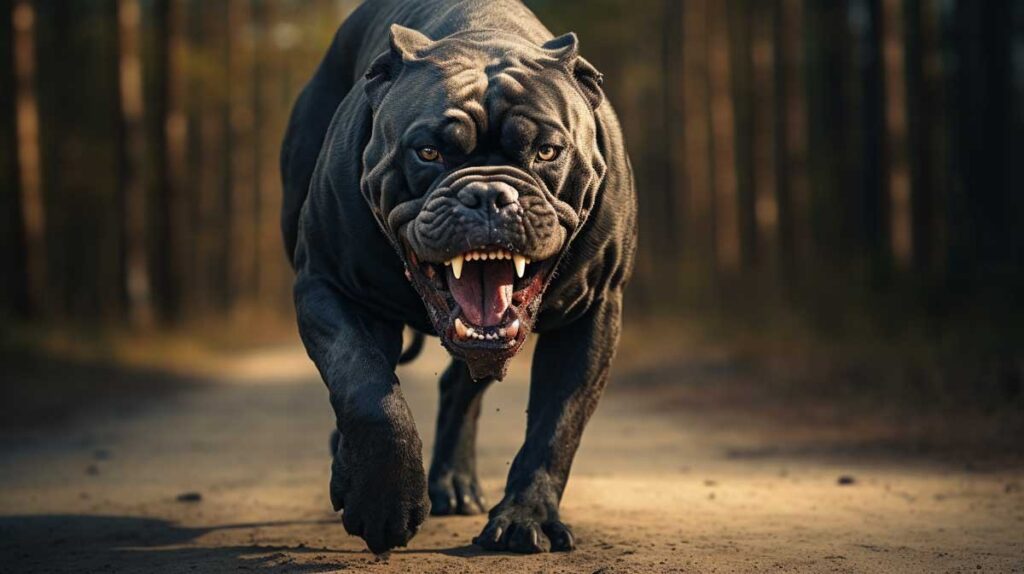
How a Cane Corso looks in appearance
The Cane Corso is a giant dog breed that projects strength and power. The breed’s muscular build and quick reflexes make it ideal for hunting, guarding, and herding, among other jobs.
Male Cane Corsos average 24 to 28 inches (61 to 70 cm) in height at the shoulder, while females are slightly smaller at 23 to 26 inches (58 to 65 cm). The breed is notably recognized for its great weight, with males averaging between 90 and 120 pounds (41 and 54 kg) and females measuring between 80 and 100 pounds (36 and 45 kg).
The Cane Corso has a broad, square head, a powerful neck, and a pronounced jawline. The breed’s thick, wrinkled skin gives it a unique and commanding aspect. The breed’s short, wide muzzle is in keeping with its otherwise massive skull proportions.
The Cane Corso has small, almond-shaped eyes set far back in its skull, and its ears are also positioned far back. Dark eyes are a common trait of the breed and contribute to its menacing appearance. Small, triangular ears perched high on the head are another defining feature of this breed.
The Cane Corso has a short, dense coat that doesn’t shed much. The coat of the breed is usually silky and lustrous. The breed is available in many colors, such as black, fawn, red, gray, and brindle.
The Cane Corso’s body and tail are both strong and athletic. The Cane Corso has a deep chest and a robust frame. This breed’s speed and grace come from its long, muscular legs. A thick, tapering tail, carried high and curved, is another distinguishing feature of this breed.
In conclusion, the Cane Corso is a vast, powerful dog breed with a unique and intimidating appearance. The breed’s colossal head, strong jaw, and sturdy body contribute to its reputation as a tough working guard dog. In addition, the Cane Corso’s robust build and quick wit have earned it widespread acclaim as a versatile working dog breed.
The distinctive temperament and character of the Cane Corso breed.
Cane Corso’s temperament and character are confident, devoted, and protective. In addition, they are renowned for being exceptionally bright, which makes training them a breeze if done correctly. They are also very loving and cherish quality time with their loved ones. In addition, they are naturally protective and distrustful of outsiders, making them excellent guard dogs.
The Cane Corso’s loving nature is one of their distinguishing characteristics. They are very loyal to their masters and will do anything to keep them safe. Unfortunately, they tend to be too protective of those they care about, which might give them a bad reputation. They may, however, learn to tell friends from enemies with the help of socialization and training.
Cane Corsos’ intellect is one of its distinguishing characteristics. They pick up on training techniques quickly and respond well to reinforcement. Because of this, they are naturally protective and frequently used as police and military dogs.
The Cane Corso also has a reputation for devotion to its human family. They are well-liked as pets because of their affectionate nature and ability to spend time with their owners. However, their size and protective instincts make them difficult to manage without proper socialization and training.
The Cane Corso is a one-of-a-kind breed because of its distinct character and demeanor. They make fantastic security dogs and friends thanks to their loyalty, intelligence, and protectiveness. However, they must be socialized and trained correctly to be well-behaved and secure with people.
Cane Corso’s typical health conditions and possible health issues
The average Cane Corso lives between 9 and 12 years. However, they can develop the same susceptibilities to illness as other dog breeds. Potential Cane Corso owners should know these health risks and deal with a reputable breeder who offers health testing and guarantees.
Hip dysplasia is high on the list of Cane Corso health problems. Hip dysplasia is a hereditary disorder characterized by abnormal hip joint development, which causes swelling, pain, and, ultimately, arthritis. The breed is also susceptible to elbow dysplasia.
The Cane Corso also has the potential to face the following medical problems:
The Cane Corso breed is prone to hip and elbow dysplasia. This condition is known as dysplasia when the ball and socket of a joint like the hip or elbow don’t line up correctly during development. Affected dogs may experience pain, discomfort, and lameness. Hereditary factors and external ones like rapid growth or intense exercise can worsen hip and elbow dysplasia.
• Dilated cardiomyopathy is characterized by cardiac enlargement and weakness that ultimately result in heart failure. Due to the breed’s potential susceptibility, Cane Corsos should have annual heart examinations.
• Entropion, where the eyelid turns inward, can cause discomfort, infection, and even permanent vision loss because the eyelashes rub on the cornea.
The tear gland in the third eyelid protrudes and becomes evident as a red lump in the corner of the eye in a disease known as “cherry eye.” It may be necessary to undergo surgery to alleviate the pain and correct the issue.
• Gastric torsion (also known as bloat) is a potentially fatal illness in which the stomach twists itself due to gas buildup, cutting off blood flow to the heart and other essential organs. Emergency veterinarian care is needed right now.
Itchiness, hair loss, and skin infections are only some symptoms of skin allergies, which may affect some Cane Corso.
Cane Corso owners should know the symptoms of these diseases so they can take their dogs to the clinic if they develop any of these conditions. The risk of health issues in this breed can be reduced with preventative care, regular veterinary examinations, and the benefits of a healthy diet and regular exercise.
Cane Corso may be more predisposed to various illnesses because of their size and build and the difficulties above. For instance, their heavy build may put them in greater danger of developing joint health problems, such as arthritis. In addition, the short coat of this breed may further increase its vulnerability to sunburn and overheating when temperatures rise. The dog’s owner is responsible for always ensuring their pet’s safety and comfort.
Cane Corso physical activity and training requirements
A Cane Corso’s physical and emotional well-being depends on getting plenty of daily activity. In addition, they need a lot of physical and mental conditioning to prevent boredom, destruction, and behavioral issues. Thus, it’s essential to meet their high exercise and training needs.
Need for Physical Activity
Physically fit and cognitively stimulated, Cane Corsos needs daily exercises like brisk walks, jogs, or runs. Athletic and playful, they enjoy swimming, hiking, and playing fetch. Furthermore, they are often champions in dog sports, including obedience, agility, and tracking.
They should engage in physical activity for 30–60 minutes daily. However, this could differ for dogs of different ages, sizes, and health conditions. Just be careful not to overheat while it’s hot outside.
Needs in Training
The Cane Corso is an intelligent dog that needs to be trained consistently and firmly from puppyhood through. However, they respond well to praise, treats, and playtime because they are eager to please their owners.
Due to their suspicious nature, Cane Corso requires extensive socialization from a young age. To develop into well-rounded, self-assured adults, dogs benefit greatly from early socialization with other canines, people, and new situations.
It would be best to take charge of the household and set rules and boundaries for everyone to follow. Because of their protective nature, Cane Corsos may resort to aggressive behavior toward strangers without adequate training and socialization.
One-of-a-Kind Requirements
The Cane Corso has specific requirements for sociability, physical activity, and training. Due to their size, they may benefit from having access to a large, fenced-in yard. To avoid destructive boredom, providing children with plenty of toys and things to do is essential.
They must be handled and socialized carefully to prevent being overprotective and aggressive towards strangers. In addition, the Cane Corso may have separation anxiety if left alone for long periods, so homes where the dog is frequently left alone may not be the best fit for this breed.
Due to their high exercise and activity requirements, Cane Corsos may not be the best choice for first-time dog owners or busy families. They do best in houses where everyone is constantly on the go so the dogs can get enough exercise, playtime, and human interaction.
Understanding the Socialization and Living Conditions of the Cane Corso: Their Specific Needs
Cane Corsos are devoted, protective dogs who benefit from early and consistent socialization. However, cane Corsos can develop behavioral issues, such as being overprotective, aggressive, and worried, if they are not properly socialized as puppies.
Cane Corsos needs large yards to run around and play in. Thus, those are the ideal living conditions for these dogs. They thrive in homes with spacious yards, but they may adjust to apartment living if given enough exercise and mental stimulation. Cane Corsos, like many other dogs, are not suited to long periods of isolation and do best with regular human companionship.
If a Cane Corso is exposed to other animals early, the dog is likelier to get along with them. However, they have a powerful predation drive. Therefore, they must be closely monitored around small animals such as cats and rabbits. Moreover, Cane Corsos are predisposed to guard their home and pack, which might make them aggressive toward other dogs.
Cane Corsos must also be properly socialized with humans. They tend to be wary of strangers and fiercely protective of their loved ones, but they shouldn’t be excessively hostile or timid. Fear-based aggressiveness can be avoided through early and persistent socialization with various individuals and environments.
Because of their stubborn nature, Cane Corsos require rigorous, constant, and positive training. Using harsh teaching techniques might result in worry and fear, leading to behavioral issues. On the other hand, cane Corsos are eager to please and learn, making them ideal candidates for positive reinforcement training.
Cane Corsos, like all dogs, needs adequate socialization to thrive as an adult. Positive, consistent training from a young age and socialization with humans and other animals is essential. Cane Corsos, when raised with children and given the correct training, make beautiful pets and trustworthy guard dogs.
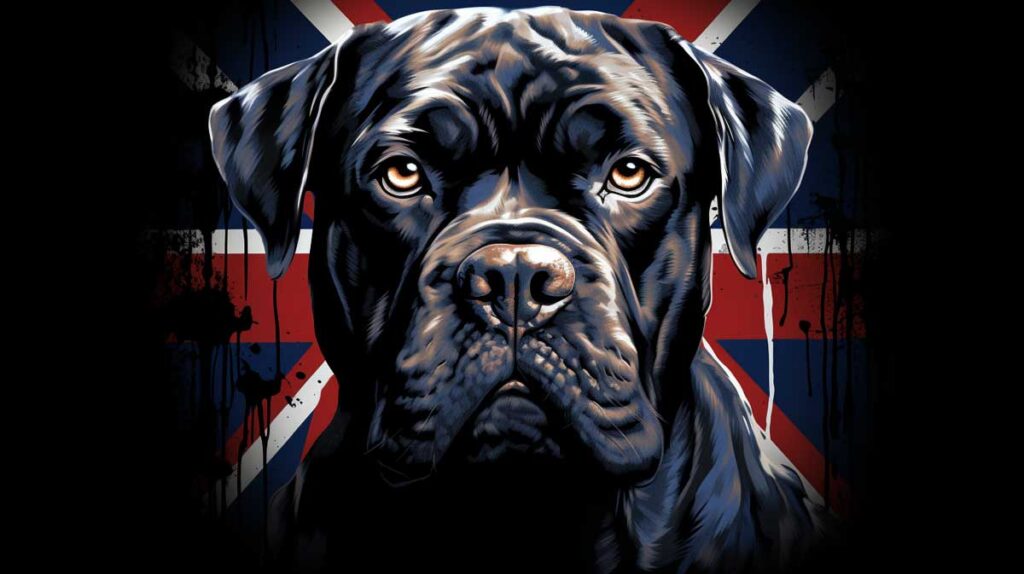
The popularity of the Cane Corso breed
The Cane Corso breed has skyrocketed in popularity in recent years, notably in the United States. The Cane Corso was the 32nd most popular dog breed in the United States in 2020, the 37th in 2015, the 48th in 2014, and the 18th in 2022, all rankings provided by the American Kennel Club (AKC). The breed’s widespread acclaim results from the rare combination of power, agility, devotion, and a lovable disposition that define it.
Some of Cane Corso’s attractive characteristics are as follows:
Cane Corsos are famously devoted to their human family members. However, because of their loyalty and protective nature, they make fantastic guard dogs.
Cane Corsos are very trainable because of their intelligence. In addition, they are a pleasure to deal with because they pick up on commands quickly and enjoy obedience training.
Cane Corsos has a reputation for having a pleasant and balanced temperament. They are not easily irritated and are lovely family pets.
This breed has a high athleticism and thrives on a daily training regimen. Hikers and runners, in particular, will find them to be excellent companions.
Adaptability to new environments: Cane Corsos do well in urban apartments and suburban mansions with yards. They are also able to adapt to various weather conditions.
Regarding health, the Cane Corso has fewer problems than other large breeds. Your Cane Corso can live a long and healthy life with the proper diet, frequent exercise, and preventative treatment.
Cane Corsos’s imposing physiques and elegant coats make them stand out. Everybody will be staring at them because of how magnificent they are.
The Cane Corso is a multipurpose breed that does well in the home and the workplace. They are frequently used as guard dog, police dog, and search and rescue dog.
The Cane Corso has a long and storied history, extending back to their usage as military dogs in Ancient Rome. The breed’s storied past is a significant lure for many admirers.
Because of its unique characteristics and adaptability, the Cane Corso can serve in several settings, such as a guard dog, a companion dog, and even a working dog in environments like the police or the military. It is a fantastic guard dog because of its strong protective instinct and loyalty and a wonderful family pet because of its gentle and friendly demeanor. The remarkable physical characteristics of the Cane Corso have also contributed to its widespread acclaim. The breed is stunning and imposing due to its robust build, smooth coat, and dominating appearance. The Cane Corso’s unique appearance and history make it a desirable option for people looking for a rare and exotic dog.
However, it should be noted that with rising popularity comes the obligation to monitor and regulate breeding techniques to protect the breed’s integrity and well-being. Prospective owners should also research to ensure the breed suits their home and lifestyle.
The Cane Corso’s comprehensive recognition results from this breed’s extraordinary qualities, adaptability, and visual appeal. However, the health and welfare of the breed depend on proper ownership and breeding techniques.
Comparing the cane corso to different dog breeds
These comparisons are made only in my opinion. As a long-time Cane Corso breeder, I met and dealt with all these breeds besides Cane Corso in different meetings, training, and daily situations. Therefore, this is again my opinion.
Tibetan Mastiff vs. Cane Corso:
Size:
Compared to the Cane Corso, the Tibetan Mastiff is an enormous dog. The Cane Corso weighs, on average, between 40 and 50 kilograms, while the Tibetan mastiff can weigh anything from 70 to 150 kilograms. The Cane Corso and the Tibetan Mastiff can be between 62 and 70 centimeters tall.
Temperament:
Both dogs are loyal to their families and have an innate desire to defend them. However, while the Cane Corso is known for being more friendly and outgoing than its Tibetan Mastiff counterpart, it is sometimes hostile toward other dogs.
Exercise:
The Tibetan Mastiff and the Cane Corso benefit from regular exercise and physical activity to maintain their health and beat boredom.
Training:
The Cane Corso and the Tibetan Mastiff are intelligent and eager to please their owners. Still, the Cane Corso is typically more trainable than the Tibetan Mastiff.
Health:
Hip dysplasia, progressive retinal degeneration, and hypothyroidism are more common in the Tibetan Mastiff . Cane Corsos have a higher risk of developing bloat, hip dysplasia, and eye difficulties.
The Tibetan Mastiff is larger and requires less activity. Still, training is more challenging and has more health problems than the Italian Mastiff. On the other hand, the Cane Corso is smaller and more active than other Tibetans, but it is less challenging to train and poses fewer health risks.
Fila Brasileiro vs. Cane Corso:
Size:
The Cane Corso is a large dog breed, often weighing 90-120 pounds and measuring 23-28 inches tall at the shoulder. The Fila Brasileiro, often known as the Brazilian Mastiff, is much larger, weighing between 100 and 200 pounds and measuring 25 to 30 inches in height at the shoulder.
Temperament:
The Cane Corso is a loving, affectionate, and protective breed that can be reserved with strangers. They are recognized for their courage and confidence and are often used as guard dogs. While both the Cane Corso and the Fila Brasileiro are guard dogs, the Fila Brasileiro has a reputation for being more hostile toward and less tolerant of outsiders. They show extreme loyalty to their families but need early and consistent socialization to avoid becoming aggressive toward strangers.
Exercise:
Like the Fila Brasileiro, the Cane Corso is a huge, high-energy breed that needs daily walks to stay healthy and content. However, they thrive when given regular exercise or time to run and play in a secure yard.
Training:
Although both breeds can be trained, the Fila Brasileiro presents unique training challenges due to its strong will and independent personality. Both types of dogs need constant and early training to ensure they mature into well-mannered pets.
Health:
Both types of dogs can experience health problems. Common health issues in Cane Corsos include dysplasia in the hips and elbows, bloating, and eye disease. Hip dysplasia, cardiac disorders, and skin problems are common in the Fila Brasileiro breed.
Cane Corso and Fila Brasileiro are both vast and protective breeds. Still, the Fila Brasileiro is much larger and can be more aggressive toward strangers. Both types might be prone to health problems and benefit greatly from regular exercise and training.
Cane Corso vs. Tosa Inu
Size:
Males in the Cane Corso breed stand at the shoulder at 25 to 27.5 inches (64 to 70 cm), while females are shorter at 23.5 to 26 inches (60 to 66 cm). Their weight ranges from 40 to 54 kilograms (88 to 121 pounds).
Male Tosa Inus measures 24.5 to 32 inches (62 to 82 cm) at the shoulder, while females measure 22 to 27.5 inches (56 to 70 cm) at the shoulder. They can weigh as much as 90 kilograms (around 130 pounds).
Temperament:
Cane Corso dogs are well-known for their devotedness to their families and protective nature. They are sometimes shy around new people but can open up after adequate socialization.
Tosa Inus is recognized for being obedient, quiet, and peaceful. However, they tend to be reserved with new people and protective of their loved ones. They need a robust and confident owner who can establish themselves as the pack leader.
Exercise:
Cane Corsos, like all dogs, need regular physical and mental activity to thrive. So they have a fenced-in yard where they can go about and play safely.
Daily walks or jogs are recommended for Tosa Inu’s moderate exercise needs. However, even in a gated yard, they need constant supervision.
Training:
Cane Corso dogs are known to be very trainable and devoted companions. However, starting teaching and socializing them early would be best since they react well to positive reinforcement training methods.
The Tosa Inu is intelligent, but it’s a challenging breed to train because it’s so headstrong. Therefore, socialization should begin young and involve a consistent, rigorous approach.
Health:
Dogs of the Cane Corso breed are susceptible to conditions like hip dysplasia, elbow dysplasia, bloat, and cherry eye.
Hip dysplasia, bloat, and skin allergies are a few health problems linked to the Tosa Inu breed.
Both dog types are massive, devoted, and watchful over their loved ones. While the Tosa Inu might be bigger and need a more dominant pack leader, the Cane Corso might be friendlier and more receptive to training and socializing. Both breeds require regular veterinary care because they are predisposed to particular health problems.
Cane Corso vs. XL American Bully
Size:
Male Cane Corsos typically stand 24 to 28 inches (61 to 71 cm) at the shoulder and weigh 88 to 120 pounds (40 to 54 kg); female Cane Corsos typically stand 23 to 26 inches (58 to 66 cm) and weigh 66 to 99 pounds (30 to 45 kg). American Bully XL males are usually 20 to 23 inches (51 to 58 cm) tall and 70 to 120 pounds (32 to 54 kg) heavy. In comparison, females are typically 19 to 22 inches (48 to 56 cm) tall and 60 to 100 pounds (27 to 45 kg) heavy.
Temperament:
While the American Bully XL and Cane Corso are recognized for their loyalty and protective attitude, the American Bully XL tends to be more approachable and pleasant toward strangers. Cane Corsos requires a rigorous and regular approach to training due to their independent and domineering nature. They make for excellent guard dogs and family defenders, but only if they are socialized as puppies. The American Bully XL is a popular pet because of its friendly personality. As a rule, they train quickly and are eager to please their owners.
Exercise:
Both breeds need frequent exercise to keep their bodies and minds in tip-top shape. Daily walks and playtime in an enclosed yard are great ways to get your Cane Corso the moderate exercise he needs. They like to go swimming and trekking as well. The American Bully XL is another breed that needs regular exercise. However, the amount of activity they need depends on their size and temperament. They learn best when training sessions include physical activity, which they like doing with toys and interactive activities.
Training:
Both breeds can be trained with the proper methods but have unique needs. Training for a Cane Corso should begin as soon as possible and be maintained with firmness and confidence. Treats, praise, and play are all effective forms of positive reinforcement training, but harsh or punitive methods might provoke aggressive behavior. The American Bully XL is one of the breeds that respond well to clicker training and other forms of positive reinforcement.
Health:
Both breeds tend to be healthy. However, there are a few conditions to which they are predisposed. Hip and elbow dysplasia, bloating, eye difficulties, and heart disease are some health issues that can affect Cane Corsos. The American Bully XL is prone to hip dysplasia, heart problems, and skin allergies. To reduce the likelihood of your dog inheriting a health problem, working with a professional breeder who screens for common ailments in breeding dogs is essential.
Both the Cane Corso and the American Bully XL are colossal dog breeds. Yet, they have very different personalities and physical requirements. The Cane Corso, often larger and heavier than the American Bully XL, must be socialized and trained early and firmly. The American Bully XL’s lovable and placid demeanor responds well to positive reinforcement training methods. Both breeds benefit from regular exercise and can reduce their risk of developing specific health problems by visiting a reputable breeder.
Dogo Argentino vs. Cane Corso:
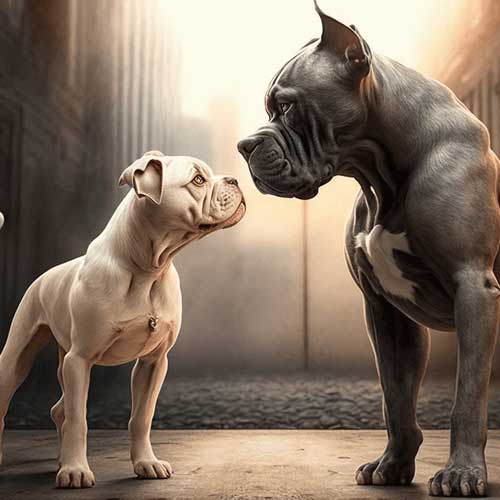
Size
The average height of a male Cane Corso is 24 to 28 inches at the shoulder, and their average weight is 99 to 110 pounds. The average size of a female Cane Corso is 23 to 26 inches, and their average weight is 88 to 99 pounds.
Male Dogo Argentinos can reach heights of 24 to 27 inches and weigh 80 to 100 pounds, while females reach heights of 24 to 26 inches and weigh 70 to 95 pounds.
Temperament
The Cane Corso is an ideal guard dog because of its reputation for loyalty and protectiveness. In general, they are calm and collected. Yet, they may also distrust strangers and be fiercely protective of those they love.
While both the Cane Corso and the Dogo Argentino are guard dogs, the former is known to be more aggressive and less tolerant of other animals. In addition, they are more active than the Cane Corso, thereby needing more exercise.
Exercise
Both dog types need regular physical and mental activity to thrive. The Cane Corso is noted for requiring less strenuous exercise than other breeds. However, the Dogo Argentino is a highly energetic breed that requires regular walks and fun to maintain its mental and physical health.
Training
Both breeds are intelligent and can be taught new tricks, but the Cane Corso’s calm demeanor could make them simpler to train. The Dogo Argentino needs regular training and socializing to reduce the likelihood of aggressive behavior.
Health
While both breeds enjoy robust health, the Cane Corso may have an increased risk of developing hip dysplasia, bloat, and eye problems. Deafness and skin allergies are possible in the Dogo Argentino breed.
The Cane Corso and the Dogo Argentino are giant, powerful breeds that benefit greatly from regular physical and mental activity. However, the Dogo Argentino’s more aggressive tendencies make it a better choice for experienced dog owners. In contrast, the Cane Corso’s temperament makes it a better choice for families with children or other pets.
Boerboel vs. Cane Corso:
Compared to the Cane Corso, the Boerboel is a somewhat larger breed, with males weighing in at 150–200 pounds and standing at 24-27 inches in height and females at 110–154 pounds, towering at 22–25 inches. Cane Corso males weigh 99–110 pounds and measure 25–27.5 inches in height, while females are smaller at 88–99 pounds and slightly shorter at 23.5–26 inches.
Characteristically, the Boerboel and the Cane Corso have a reputation for fiercely protecting their families and territory. The Cane Corso is more trainable and social, whereas the Boerboel is more dominant and independent.
Both breeds need daily walks, but the Boerboel may require more challenging exercise because of its greater size and higher energy level. Daily walks are sufficient for the Cane Corso. Still, the Boerboel may benefit from more vigorous activities like running or hiking.
The Cane Corso is a good choice for obedience and protection training due to its intelligence and trainability. The Boerboel may also be trained, a bit more independently and vigorously, requiring a more skilled trainer.
When it comes to health, hip and elbow dysplasia, as well as bloat, are common problems in both breeds. While the Cane Corso may have an increased risk of eye problems, the Boerboel is predisposed to cardiac problems.
The Boerboel is a more robust and self-reliant breed than the Cane Corso. Exercise and training are essential for both breeds, but the Boerboel may require more structure and a knowledgeable handler. The Boerboel may have a higher chance of cardiac disorders. In contrast, the Cane Corso may have a higher risk of eye problems. Still, both breeds are susceptible to specific health difficulties.
Golden Retriever vs. Cane Corso
Males of the Cane Corso breed average 24–28 inches in height and 90–120 pounds, while females are slightly smaller at 23–26 inches and 80–100 pounds. Although smaller than Cane Corsos, Golden Retrievers are nonetheless quite sizable. They are between 55 and 75 pounds and 21.5 and 24 inches tall for males and 20 to 22.5 inches for females.
Cane Corsos are known for being courageous, intelligent, and protective because of their temperament. They are devoted to their loved ones, yet they may treat others with hostility. Therefore, they must be socialized and trained to prevent aggressive behavior. Conversely, Golden Retrievers are social, outgoing, and eager to please. They make excellent family dogs because they get along well with kids and other animals and are generally not aggressive toward strangers.
Daily exercise is recommended for both dog types, but larger, more active breeds like Cane Corsos need more training. They thrive on daily walks, jogs, and fun in a secure yard. In addition to getting their daily walk, Golden Retrievers benefit from interactive games of fetch, swimming, and other sports.
They are both intelligent and trainable but require distinct approaches to training. While Golden Retrievers are eager to please and react well to positive reinforcement training methods, Cane Corsos needs early socialization and obedience training to prevent violent behavior. They are frequently employed in rehabilitation, search and rescue, and service.
• Health: Cane Corsos are typically healthy, but they are prone to various health disorders, including hip dysplasia, bloat, and cardiac difficulties. Hip dysplasia, cancer, and heart difficulties are all conditions that can affect Golden Retrievers. They also face the increased danger of becoming overweight.
Although Cane Corsos and Golden Retrievers are beautiful dogs, their personalities, energy levels, and training demands differ. Golden Retrievers are amiable and eager to please, but Cane Corsos are protective and need socialization and obedience training.
Pit Bull Terrier vs. Cane Corso
Size:
The average Cane Corso weighs 88–120 pounds and measures between 23 and 27 inches at the shoulder. However, Pit Bull Terriers are considered medium-sized canines due to their average weight of 30–70 pounds and height of 17–21 inches at the shoulder.
Temperament:
Cane Corsos has earned a reputation as a trustworthy and reliable guard dog. They are timid and quiet among strangers, but make great family pets. They need early socialization and instruction to prevent them from developing aggressive personalities. Like Cane Corsos in their loyalty and protectiveness, Pit Bull Terriers are also high-energy and playful. Again, they need extensive early socialization and training to prevent them from developing aggressive tendencies.
Exercise:
Both types of dogs need frequent exercise to be fit and trim. Cane Corsos are moderately active dogs that need daily walks and playtime but are content with less. However, Pit Bull Terriers need more significant physical activity due to their high activity levels. They get a lot of pleasure from vigorous physical exercise like running, playing fetch, and the like.
Training:
Cane Corsos and Pit Bull Terriers are high-intelligence dog breeds that benefit from rigorous, regular training beginning in puppyhood. Cane Corsos can sometimes be stubborn and require a firm but gentle hand in training. Pit Bull Terriers are eager to please their owners and react well to positive reinforcement training methods.
Health:
While Cane Corsos rarely become sick, they are predisposed to a few conditions, such as hip dysplasia, bloat, and heart disease. Pit Bull Terriers are also usually healthy. However, they can be prone to skin allergies, hip dysplasia, and certain types of cancer.
In sum, each breed is interesting in its way and can be a wonderful friend to the proper person. However, before introducing one of these breeds into your house, you should do your homework and be sure you can give it the attention it needs.
Cane Corso vs. English Bulldog:
The Cane Corso is a huge dog, while the English Bulldog is considered medium. The average Cane Corso dog weighs around 120 pounds and has a shoulder height of about 27 inches. In comparison, English Bulldogs weigh about 40-50 pounds and stand about 14-15 inches tall at the shoulder.
Cane Corsos are noted for their brilliant minds, undying loyalty, and fierce guarding instincts. They are also highly trainable and make excellent guard dogs. However, English Bulldogs have a reputation for being friendly and laid-back. These animals are excellent companions for families with young children.
Cane Corsos, like all dogs, require regular physical activity and play to maintain a healthy and happy lifestyle. They need to run around and get their energy out every day. However, unlike Cane Corsos, English Bulldogs don’t need as much activity. They are more flexible and can make do in restricted quarters.
Cane Corsos are very trainable and learn quickly when rewarded for good behavior. Because of their intelligence and trainability, they can become excellent obedience, agility, and tracking dogs. However, while trainable, English Bulldogs sometimes need a hand when being trained because of their stubborn nature.
Cane Corsos are typically healthy dogs. However, they have a higher risk of developing hip dysplasia, cherry eye, and bloat than other breeds. However, English Bulldogs are prone to many health problems, including asthma, skin allergies, hip dysplasia, and heart disease.
Cane Corsos and English Bulldogs both have many distinguishing features that set them apart from one another. Compared to the English Bulldog, the Cane Corso is a larger, more protective dog that needs more activity and training. Both breeds have the potential to be excellent companion animals, but knowing the distinctions between them can help you pick the best one for you.
Cane Corso vs. Great Dane
Size:
• The Great Dane is one of the giant dog breeds, with an average weight of 110–190 pounds (50–86 kg) and a height of up to 32 inches (81 cm) at the shoulder.
• The Cane Corso is also a huge breed but is smaller than the Great Dane, standing up to 27.5 inches (70 cm) tall at the shoulder and weighing between 88 and 110 pounds (40 and 50 kg).
Temperament:
In addition to being excellent guard dogs, both breeds are well-known for their loyalty and protective nature.
• The Cane Corso can be more reserved and cautious with strangers. In contrast, the Great Dane is usually more friendly and pleasant.
Exercise:
To avoid becoming overweight, a Great Dane needs regular, moderate activity, like going for walks and short runs.
• Daily walks and playtime are essential for the physical and mental health of your Cane Corso and will help deter harmful behavior.
Training:
• The Great Dane has a more independent spirit than the other breed, but they are both intelligent and trainable.
The Cane Corso responds well to positive reinforcement and is easier to teach than other dog breeds.
Health:
• Great Danes have shorter longevity than Cane Corsos, with an average lifespan of 6–8 years compared to the Cane Corso’s 9–12 years.
Bloat, hip dysplasia, and heart disease are just a few common health problems that can affect Great Danes. In addition, cane Corsos often suffer from eye and skin problems and hip deformities.
If you have the room and time to devote to your pet, either breed will make an excellent addition to your family. However, the Cane Corso is a more reserved and protective dog. At the same time, the Great Dane is better suited to individuals who are searching for a more outgoing and chill friend.
Boxer vs. Cane Corso:
Cane Corso dogs are larger than Boxer dogs. Male Cane Corso adults typically range in size from 90 to 120 pounds and 25 to 27 inches in height. However, adult male Boxers typically range from 65 to 80 pounds and 22 to 25 inches in height.
Both breeds have distinct personalities. Boxers are recognized for their outgoing and energetic disposition, whereas Cane Corsos are noted for their peaceful demeanor. Boxers are more outgoing and social than Cane Corsos, who are more guarded and shy around strangers.
The physical and mental health of both breeds depends on regular exercise. To maintain their health and avoid becoming overweight, Cane Corsos require daily walks and fun. Boxers, like most high-energy dogs, need regular vigorous activity, including walks, runs, and plays.
Both breeds are trainable and smart, but they have different needs regarding education. Cane Corsos are notoriously headstrong and need tough, persistent training from puppyhood onward. On the other hand, boxers are very trainable and learn quickly when rewarded for their efforts.
Regarding health, both types of dogs might have their share of problems. Hip and elbow dysplasia, bloat, and eye problems have been observed in Cane Corsos. In contrast, heart disease, cancer, and hip dysplasia have been observed in Boxers. Both dogs must see the vet regularly and eat well to stay healthy.
Overall, with the proper training and care, both the Cane Corso and the Boxer can be wonderful family dogs despite their differences.
Doberman Pinscher vs. Cane Corso
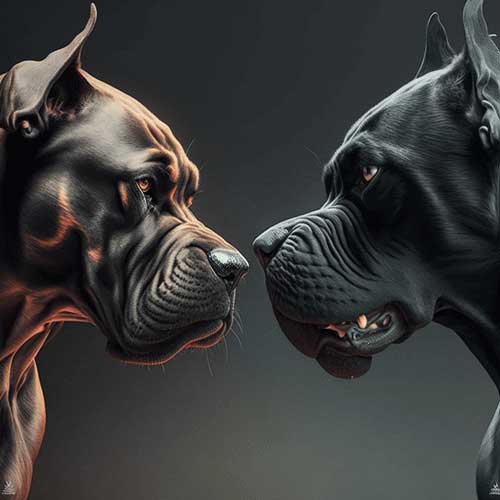
When compared to the Doberman Pinscher, the Cane Corso is noticeably larger. Cane Corsos tend to be heavier than Doberman Pinschers, with an average weight of 88–120 pounds. The Cane Corso is also taller than the Doberman Pinscher, with both dogs measuring about 24–28 inches at the shoulder.
There are considerable differences in temperament between the Cane Corso and the Doberman Pinscher. Still, both are intelligent, loyal, and protective. However, the Doberman Pinscher is more active and alert than the Cane Corso, who is regarded as being calm and quiet. While both can be trained to be adequate security dogs, the more laid-back Cane Corso may be better for households with small children.
Both breeds need regular physical activity to stay healthy and prevent boredom. However, while both breeds benefit from regular walks and playtime, the Doberman Pinscher needs more vigorous exercise like running and agility training.
Both dog breeds are smart and eager to please, making training easy. However, Cane Corso may need a firm and consistent trainer to overcome their occasional stubbornness. Because of its heightened sensitivity, the Doberman Pinscher may benefit more from positive reinforcement training techniques.
Regarding health, both breeds are comparable, but each has unique issues. For example, hip dysplasia, elbow dysplasia, and bloat are possible health issues for Cane Corso dogs. In contrast, the Doberman Pinscher is at risk for developing heart disease, von Willebrand’s disease, and hip dysplasia.
The Cane Corso and the Doberman Pinscher are two fantastic dog breeds, each with its own set of qualities. When deciding which dog breed to adopt, you must consider your lifestyle and requirements to ensure that you select the most suitable companion.
German Shepherd vs. Cane Corso
The Cane Corso is a huge dog with an average weight of 90–120 pounds and a 23–28-inch height. The German Shepherd is a big dog, too, coming in at 50 to 90 pounds and 22 to 26 inches at the shoulder, although it’s smaller than the Cane Corso.
Characteristically, the Cane Corso dog breed is noted for its devoted, guardian, and loving nature toward its human family. However, if not appropriately socialized, they may be distrustful of strangers and even hostile toward them. The German Shepherd is just as devoted to and protective of its pack. Still, it’s also far more friendly and extroverted toward outsiders. In addition, they’re well-known for their smarts and adaptability to training.
Both breeds’ physical and mental well-being depend on plenty of daily activity. At least an hour of daily exercise is ideal for the Cane Corso. This can involve brisk walks, runs, or even good old-fashioned playing. The German Shepherd should also be exercised daily for at least 60 minutes and may need more strenuous activities like running, hiking, or agility training.
Both breeds are highly clever and amenable to training, though they may have distinct needs. Training a Cane Corso is essential because of the breed’s obstinate and independent nature. Positive reinforcement works well with the German Shepherd, but harsh training methods can easily traumatize it.
The health of both breeds is good overall, yet they each have weaknesses. Hip dysplasia, elbow dysplasia, heart disease, and bloat are all common in Cane Corsos. Hip and elbow dysplasia, allergies, and digestive problems are also common in the German Shepherd.
The Cane Corso and the German Shepherd are both large, active dogs. Still, their personalities, coats, and colors set them apart. Early and persistent training is essential for both breeds, and owners should be aware of potential health problems.
Conclusion
The Cane Corso is an exceptional dog, with several distinguishing features that set it apart from other canine varieties. Understanding Cane Corso’s advantages and disadvantages requires a comparison to other breeds. This will aid prospective owners in deciding whether or not the breed is suitable for their family, residence, and training skills.
Here are some last considerations and suggestions to bear in mind if you’re looking at the Cane Corso breed:
• A well-adjusted Cane Corso temperament results from early socialization and training.
They need regular physical and mental activity to stave off destructive boredom.
You should only get a Cane Corso from a respected breeder who offers health guarantees if you want to avoid any problems.
This breed may be an excellent choice if you have the time, energy, and resources to devote to your dog’s care.
Cane Corsos is known for its protective and guarding attitude. Therefore, prospective owners should think carefully about whether or not they can create a secure environment for their dogs.
The proper owner will benefit greatly from the companionship of a Cane Corso since this breed is both loyal and impressive. In addition, they may be wonderful companions for any household if given a chance to learn and socialize properly.
